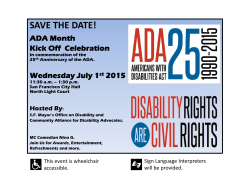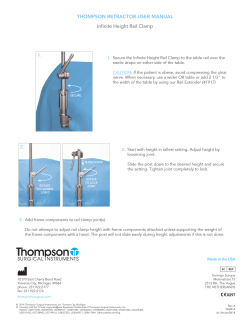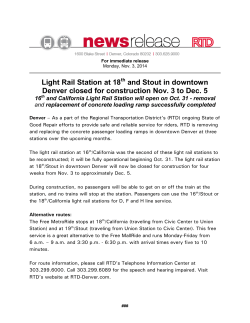
Transit Modes Descriptions
TRANSPORTATION MODE SUMMARY Bus Transit BUS TRANSIT PHYSICAL DESCRIPTION Local Bus Uses existing roadway Operates with existing traffic Headways – Flexible Frequent stops Variety of service options Familiar vehicles On-board fare collection Can change route/service easily ADA accessible Same vulnerabilities as an automobile Express Bus Uses existing roadway Operates with existing traffic Headways – Flexible (often less frequent than local bus) Fewer stops Quicker travel times Familiar vehicles On-board fare collection Can change route/service easily ADA accessible Same vulnerabilities as an automobile Bus Rapid Transit (BRT) “Light Rail on Tires” Exclusive lanes Faster travel times More reliable than local bus Fewer stops - Typically ½ to 1 mile Stations with shelters/seating Variety of service options Off-board fare collection Next Bus Information ADA accessible Some but not all same vulnerabilities as an automobile 1 BUS TRANSIT ATTRIBUTE SUMMARY Attribute Capacity Range Varies by frequency/headways Access Wide range Cost $ - $$ Operating Characteristics Accessibility Qualitative Advantages Assumptions Range of headways between 2 hrs. to 5 minutes Follows roadway grades Flexible service Variety of fuels – grades limit performance Local bus service could have many stops BRT service fewer stops Express Bus fewest stops High end includes double exclusive lanes, new vehicles, stations, TSP, ticket vending, etc. Varies based on amenities ADA Accessible Practical Economical Recognizable branding Stations can be similar to rail stations ADA Accessible 2 Rail Transit RAIL TRANSIT PHYSICAL DESCRIPTION Light Rail Exclusive Rights-of-Way (can operate in mixed traffic) Stops – Typically ½ to 1 mile spacing Service frequency dependent on single track or double track, demand Vehicle modification required to engage rack (cog rail if necessary) Can travel on grades up to 15%-25% Electric overhead power is typical Off-board fare collection Connection to existing system on Wasatch Front ADA Accessible All-weather reliability Commuter Rail Exclusive Right of Way Stations – Typically 5 to 10 mile spacing Service frequency dependent on single track or double track, demand Limited to 2.5% sustained grades Diesel/Electric or electric overhead power Off-board fare collection Connection to existing system ADA Accessible All-weather reliability RAIL TRANSIT ATTRIBUTE SUMMARY Attribute Rail Type Light Rail Capacity Commuter Rail Light Rail Operating Characteristics Commuter Rail Accessibility Light Rail Commuter Rail Qualitative Advantages Light Rail Commuter Rail Range Assumptions Scalable – headways and # of cars/train can be varied to accommodate demand Scalable – headways and # of cars/train can be varied to accommodate demand Grades up to 15%-25% (cog system) ½ - 1 mile typical station spacing 65 mph max. train speed (slower in rack sections) Limited to 2.5% sustained grades, short distances up to 4% 5-10 mile typical station spacing 79mph max train speed ADA Accessible Reliable Attractive Predictable Varies by frequency/headways 3 Aerial Transportation AERIAL TRANSPORT PHYSICAL DESCRIPTION Gondola Ropeway (steel cable) Fixed or detachable cars 8-180 people per cabin Limited by wind speeds 3768 mph Limited by electrical storms Travel speed 14 - 22 mph Electrically powered ADA Accessible Aerial Tram Description Same as Gondola Ropeway (steel cable) Fixed or detachable cars 8-180 people per cabin Limited by wind speeds 37-68 mph Electrical Storms Travel speed 14 - 22 mph Electrically powered ADA Accessible Funitel Description Same as Gondola Ropeway (steel cable) Fixed or detachable cars 8-180 people per cabin Limited by wind speeds 3768 mph Electrical Storms Travel speed 14 - 22 mph Electrically powered ADA Accessible AERIAL TRANSPORT ATTRIBUTE SUMMARY (3S Gondola Example) Attribute Capacity Operating Characteristics Access Parking Accessibility Footprint Safety Range Depends on car spacing Assumptions Less scalable, but can add/remove cars 17 mph gondola speed 1.5 min through angle station Stations and Ski Areas Large parking lots needed at termini ADA Accessible Appx 9500 ft max. tower spacing between towers Appx 200 ft max. tower height Tower footing 3 ½ feet by 3 ½ feet (4 feet per tower) Stations 66-ft wide by 125-ft long Access required to towers for construction, power, evacuation and rigging cable (road or helicopter) Accidents Safety comparison – Aerial systems are 90% safer than highway (from National Ski Areas Association) Avalanche Path Avoidance Through tower placement With vertical clearance Evacuation 4 AERIAL TRANSPORT ATTRIBUTE SUMMARY (3S Gondola Example) Attribute Qualitative Advantages Range Assumptions Attendant in cabin or at station Winch horizontal or rope vertical rescue Iconic Innovative Attraction Provides a view Highly visible Chairlifts It is important to note that chairlifts are NOT included in this primer on transportation modes. While lifts do transport people from one place to another, lifts are not considered a mode in the Mountain Accord process for the following reasons: Not ADA accessible Limited function, such as not useful for work or shopping trips Usually limited in their seasonality Therefore, the “One Wasatch” concept of linking resort areas via chairlifts, is not considered a valid transportation concept. 5
© Copyright 2025









